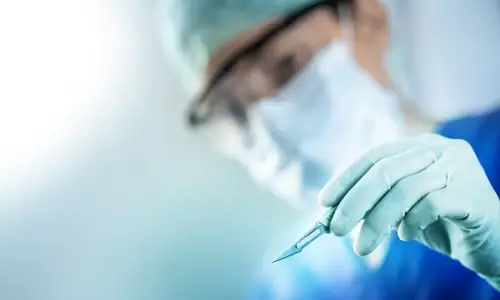Penile Suspensory Ligament
Does cutting the suspensory ligament lengthen a penis? What are the side effects of a ligament ligation? Is this procedure successful and is it worth the cost and recovery?
Most men investigating penile lengthening have encountered medical illustrations of “before and after” a ligament release procedure to lengthen a man’s penis.
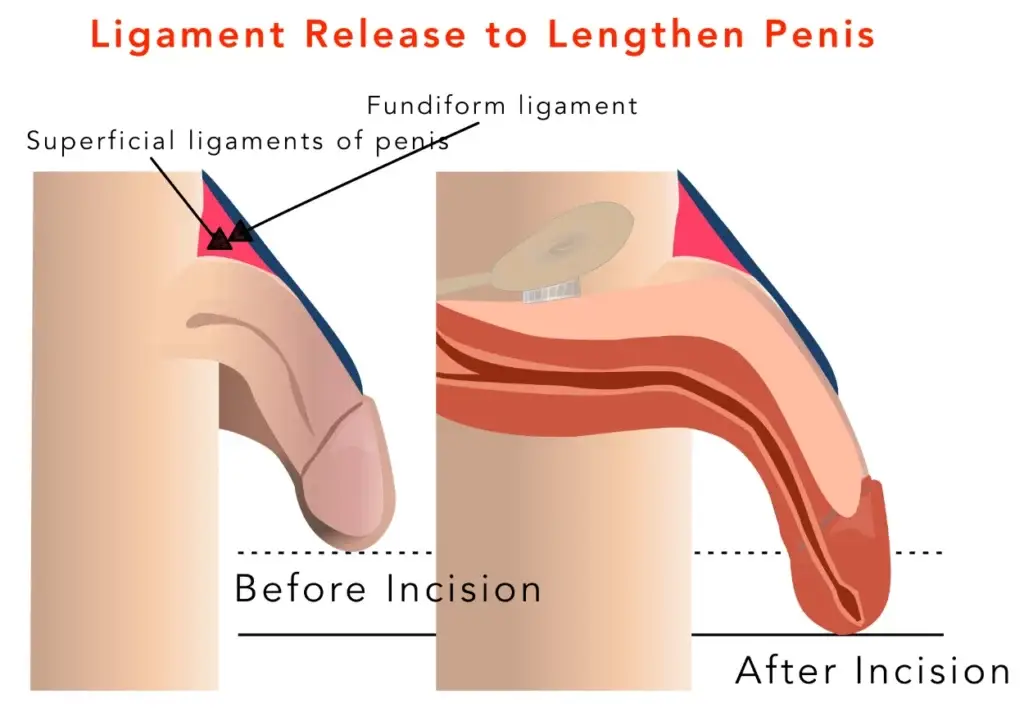
The penis length on the left (before) is comparatively shorter in length than the one on the right (after). All a man has to do is get a few ligaments cut and his penis is magically longer, right? Not necessarily. . .
Does this procedure work? What are the actions performed? What are the risks? Is there anything better suited to add penis length?
Before we answer all that, let’s start with a few basic matters about human anatomy and ligaments:
What is a ligament?
A ligament is a fibrous membrane utilized for the purpose of suspending an organ or anatomical component. They are comparable to “guy wires” you may have noticed supporting a telephone pole, and they provide support for various anatomical components of the human body.
Where are examples of suspensory ligaments within the human anatomy?
There are many suspensory ligaments found within human anatomy. Some of the most prominent suspensory ligaments in the human body are listed below:
The Suspensory Ligament of the Axilla: Alternatively referred to as Gerdy’s ligament (after French physician Pierre Nicolas Gerdy who first discovered it), this ligament establishes a connection between particular anatomical components located in the pectoral region of the chest and the underarm.
Cooper’s Ligaments: These are the suspensory ligaments responsible for maintaining the breasts’ structural integrity. They are named after the 1840 inventor Astley Cooper, who first described them.
Clitoris Suspensory Ligament: This is a fibrous band situated at the deep fascial level. It serves to connect the clitoris to the pubic symphysis by extending from the pubic symphysis to the deep fascia of the clitoris. The clitoris is supported by the pubic symphysis joint by virtue of this connection. Swelling and shortening of the clitoral ligament occur during sexual arousal. This causes the clitoral glans to appear to retract beneath the clitoral hood by pulling the clitoral shaft.
The Suspensory Ligament of the Duodenum: This ligament connects the junction of the duodenum and the small intestine; it is a supporting structure located in the gastrointestinal tract. The suspensory muscle frequently establishes an attachment with the duodenojejunal flexure and the third and fourth portions of the duodenum, although this is not always the case.
Suspensory Ligament of the Eyeball: This ligament prevents the eyeball from descending from its orbital trajectory and maintains and supports the eyeball in its typical forward and upward position. It is occasionally referred to as the Lockwood ligament, after the British surgeon who first identified it. It extends beneath the eyeball, connecting to an additional pair of ocular ligaments.
Suspensory Ligament of the Lens: A series of fibers connects the ciliary body of the eye’s lens to the circular structure that supports the iris (the pigmented portion of the eye). The diameter of the ciliary muscle enlarges in response to relaxation, while the suspensory ligaments contract and draw the lens inward.
Suspensory Ligament of the Ovary: Connecting the ovary to the wall of the pelvis is a continuous tissue known as the suspensory ligament of the ovary. It aids in the preservation of the ovarian position.
Suspensory Ligament of the Penis: This is a group of ligaments that are anchored to the pelvic bone and offer structural support to the penis when erect. They are not directly tethered to the corpus cavernosa (penile organ) but rather to the tissue surrounding it.
The Suspensory Ligament of the Thyroid Gland: The pharynx contains the suspensory ligament of the thyroid gland, also known as the ligament of Berry. It establishes a connection between the posterior thyroid and the ring-shaped tracheal cartilage. This ligament also prevents the thyroid gland from receding into the mediastinum and facilitates digestion.
Penile Lengthening: A Brief History
Why do men seek surgery in an attempt to enlarge their penis?
Studies show that most men would like to have a bigger penis; who would have possibly guessed that?
The desire has been a part of male culture since the beginning of time. Some of the very first drawings from ancient humans discovered upon cave walls included imagery of large penises. During the dawn of civilization, a large penis symbolized fertility and strength, distinguishing its owner as extraordinary, and thus more appealing to female partners. Although thousands of years have passed since, a man’s desire to be perceived as the “better choice” among females remains a priority to this day.
In modern times, men frequently leverage their locker room length into self-esteem and self-confidence, or a lack thereof. Therefore, men with an average-sized penis are actually just as likely to seek penis enlargement as those with small genitalia.
The medical term for this diagnosis of genital discontent is known as “small penis syndrome (SPS).” Most commonly, the men afflicted don’t report dissatisfaction in their personal life or sexual life, and most also report a healthy libido. However, they do experience decreased sexual satisfaction over the issue. Research indicates that penis enlargement increases sexual gratification in men suffering from SPS.
Healthcare and ligament ligation: what are the issues?
Patients often assume if they’re getting a ligament release for penile lengthening or non-surgical injections for increased girth, that the outcome will essentially be the same regardless of which doctor they visit. Nothing could be further from the truth.
Unfortunately, there are no clinically accepted “standards”1 for procedures or precise techniques involving penile enlargement at this time. The most proficient surgeons who create significant advancements are unlikely to divulge those insights to other medical professionals due to the limited clinical presence of the field and the perception that all practitioners are direct competitors.
Given the current state of affairs, where favorable healthcare evaluations are frequently “purchased and paid-for” to the extent that they resemble numerous products on Amazon, it is unsurprising that patients are easily confused.
As previously stated in other news articles, we strongly recommend that potential enlargement patients begin their research at The Phalloboards, an organization that has emerged as the “Consumer Reports” of penile enlargement procedures. Although the website does permit advertisers, those clinics have been thoroughly evaluated by members to ensure they deliver high-quality outcomes.
It is strictly prohibited for clinics to engage in discussions in the main content areas; such posts are considered candid and based upon facts. Upon reading at the Phalloboards, you will soon discover that some of the most prominently advertised companies perform sham procedures, while you will also encounter excellent surgeons in your area that you probably have never heard of before.
[1] Vardi Y, Harshai Y, Gil T, Gruenwald I, Gruenwald I. A critical analysis of penile enhancement procedures for patients with normal penile size: surgical techniques, success, and complications. Eur Urol. 2008;54(5)
The medical challenge of penile lengthening

You are in luck if increasing the girth of your penis is your top priority. Penile thickness is increased by adding one of several optional bulking agents to the tissue layers that surround the penis organ.
The considerable stretchability that human tissue can eventually attain in terms of thickness is virtually without restriction.
How much thickness can safely be added in a single procedure and whether or not the patient will be pleased with the resulting change in penile shaft proportions are the primary limitations with increasing girth.
Safety is of the utmost priority with increased thickness. Prior research at the Phalloboards is crucial for success in order to ascertain the safety of the procedure under consideration, as some procedures are anything but.
Increasing penile length is substantially more difficult due to the fact that a penis is a human organ. As the encircling layers (which are augmented in volume to achieve greater thickness) are merely human tissue, a penile girth enhancement is comparable to augmenting the female breasts.
Despite significant advances in medical science, it is still not possible to enlarge any human organ. Patients are aware that they cannot visit a physician and request that their eyeballs be enlarged by 30% or their kidneys made 20% bigger.
A recent study hypothesized that the best solution for penile lengthening is likely associated with the convergence of various medical disciplines, including urology, andrology, psychology, and plastic surgery.
This notion not only incites considerable scholarly discourse but also fosters the development of novel, efficacious surgical methodologies.
Recent cutting-edge advancements in penile lengthening include clinically-managed penile traction and innovations in which a portion of the penis organ that is currently located within the patient’s body is permanently repositioned outward.
Penile Suspensory Ligament Procedures to Lengthen the Penis
What are the penile suspensory ligaments?
The suspensory ligaments are actually three unique sets of ligaments and connective tissues that combine to support the penis during erection. How do the ligaments do that?
Since some physicians refer to their lengthening procedure as a “ligament release,” patients sometimes get the impression there’s a singular ligament that’s incised. In reality, this is not the case at all.
“Penile suspensory ligaments” are, in fact, composed of three distinct groups of connective tissue. Comparable to a ligature emanating from the body, the fungiform ligaments envelop the penis like a noose and regulate its lateral motion.
Due to their easy accessibility, the “upper superficial ligaments” are the ones that penile lengthening doctors most frequently incise.
Above the base of the penis, the upper suspensory ligaments are affixed to the fascial layers that lie beneath the suprapubic fat pad in the epidermis.
Typically located approximately one inch under the epidermis, the “deep ligaments” are joined to the pelvic bone to give the penis its most powerful anchoring support.
No two men have identical penile suspensory ligaments, as variations exist regarding their exact number, dimensions, shape, and tautness.
Although a skilled urologist can assess the fundamental nature of a patient’s penile suspensory ligaments through a physical examination, their exact circumstances (i.e. are they enlarged or unusually tight?) cannot be determined until during surgery.
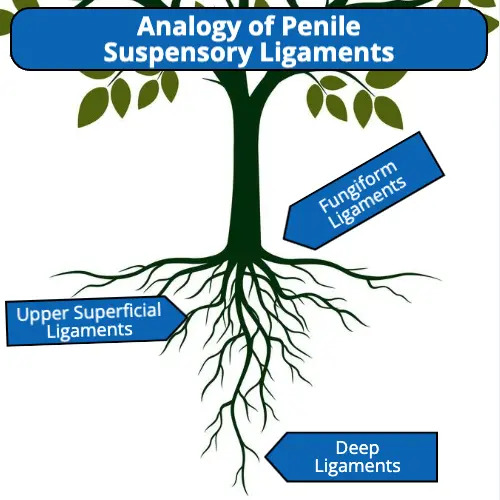
What is cutting of the suspensory ligaments to lengthen the penis?
Developed in 1971, ligation of the suspensory ligaments to lengthen the penis remains a common approach to penile lengthening to this day. Sadly, many doctors only perform ligation of the upper suspensory ligaments, which studies show has little or no benefit to penile lengthening 2
Currently, the most common penis lengthening procedure includes a complete ligation of all the suspensory ligaments in combination with V-Y-shaped skin plasty, which can make the penis appear longer.
All of these versions result in a high probability of scar deformation, as well as risk of penile retraction, insufficient cosmetic effect, and, as a consequence, low patient satisfaction with the result of surgery.
Non-urologists often generally refer to penile lengthening procedures as a “ligament release.” This implies that a penile ligament release is a rather generic procedure, creating confusion for patients since this simply isn’t true when there are a wide range of versions out there.
Here we’re going to explore the urologic rationale behind releasing the ligaments to lengthen the penis, the different penile lengthening procedures that are available, and the advantages and disadvantages of each approach.
[2] Chi Ying Li, et al Penile Suspensory Ligament Division for Penile Augmentation: Indications and Results, European Urology, Volume 49, Issue 4, April, 2006. Pages 729-733
What is the urologic rationale behind cutting ligaments?
There are a couple of urologic justifications for this procedure.
Certain males are born with ligament structures that are abnormally tight. Therefore, upon surgical incision of these tendons, a typical and immediate increase in penile length is observed. Unfortunately, excessively taut ligaments affect less than twenty percent of males.
By releasing the suspensory ligaments, it is therefore uncommon to induce an immediate and enduring difference. In fact, a lack of post-operative stretching, and retraction caused by scar tissue that forms as the incision begins to recover can cause some men to experience lost penile length.
A separation of the ligaments at the base of the penis enables post-surgical penile stretching to increase penile length for all other individuals. But what if, in addition, the deep ligaments were not also removed? The aforementioned probability approaches zero.
Attempting to stretch a penis strenuously while deep ligaments remain attached is nearly always unsuccessful and can cause damage to the penile organ or even development of Peyronie’s disease due to excessive weight and aggressive regimens.

What are the side effects of cutting the penile suspensory ligaments?
What are the side effects of a penile ligaments release?
Reduced Structural Support
The penile suspensory ligaments provide structural support and stabilization of an erection during sexual activity by attaching midline to the penile root. Cutting the suspensory ligament can cause an erect penis to be less stable. Where this really comes into play is with the sexual position known as “reverse cowgirl” where a partner is on their knees facing away from a man and backing up their lower section to slide down on the erect penis. In that position, a man who’s had a full ligament release will need to position his fingers at the base of his erect penis to provide support against the force pushing against the foundation. If the “reverse cowgirl” position is your preferred position during sexual activity? A ligament release might not be in your best interest.
Ligament Reattachment
There’s also a risk the ligaments can re-attach, causing a shortened appearance of the penis. However, our research indicates this risk is overplayed by surgeons after a ligament release fails to increase length following surgery. As exhibited, some of the most popular procedures for penile lengthening offer little chance for increased length. If a patient ends up even shorter than when he started and complains, a clinic can point to the likelihood that the “ligaments reattached,” which is included with all pre-surgery warning paperwork. There’s no way for a patient to prove that didn’t occur. However, based upon a 20-patient study of men who arrived at our clinic for repair of lost length following a penile lengthening procedure, only two patients lost their length because of ligament reattachment.
The Penis Will Not Point Straight Downward
The claim propagated by clinics that do not perform penile lengthening that, once the ligaments are released, the penis will point directly downward is unfounded and akin to an old wives’ tale. Even if a patient paid extra for our surgeon to create an erection that pointed straight downward, we could not produce such a result.
An approximate 15% reduction in the upward angle of an erect penis is seen when a male is in a standing position following most ligament ligations.
Variations Between Penile Lengthening Procedures and Outcomes
#1 Do your homework.
Because there are no agreed upon operating standards for penile lengthening procedures, actual post-operative results vary widely from one doctor to the next.
Patients should be vigilant in their research on patient-driven, unbiased clinical review websites like the Phalloboards since several of the most well-marketed clinics are generally recognized as having the worst outcomes.
#2 Recognize the difference between “patients reporting” vs. “guaranteed outcomes.”
When conducting a comparative analysis of lengthening procedures offered by different clinics, it is important to distinguish between statements such as “our patients report length increases ranging from 1-2 inches” and “we provide procedures that guarantee a length increase of 1-2 inches.” The first statement makes no promises regarding penile lengthening.
We discovered that one clinic told a patient they “anticipated his length would increase by up to five inches.” However, he presented at our facility for assistance one inch shorter than he had been before the procedure.
Avoid being duped or confused by double talk, and make sure the facility you choose provides a clear guarantee about outcomes.

#3 Understand compliant patients vs. non-compliant patients.
Almost every penile lengthening procedure involves a good bit of post-operative aftercare exercises which patients need to perform at home to help ensure an optimal outcome.
However, studies show only about 25% of penile lengthening patients are compliant with their prescribed post-operative care.
That’s another reason some lengthening procedures provide such dismal results, as some are completely dependent upon this post-procedure regimen to increase penile length.
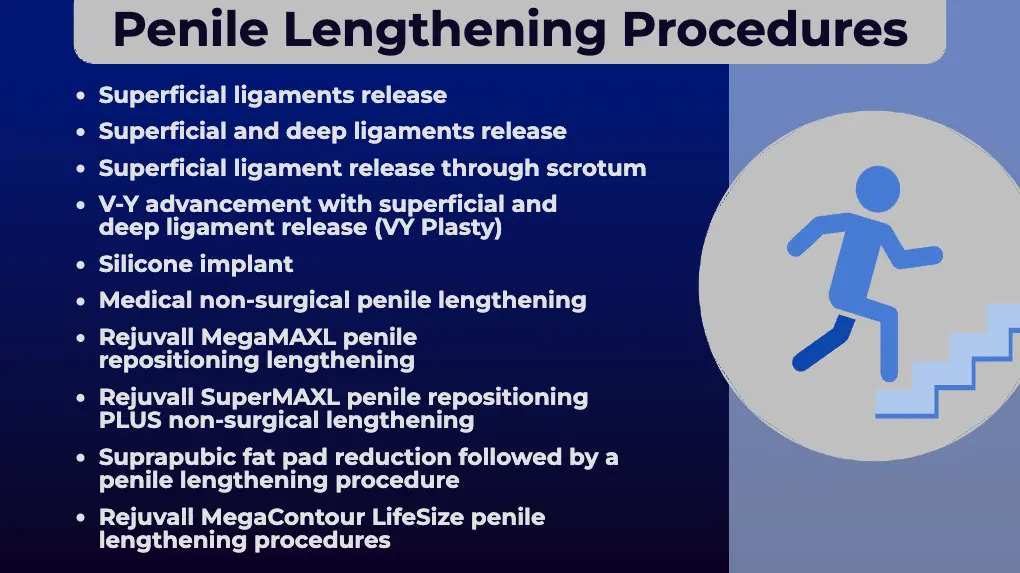
Superficial ligaments release
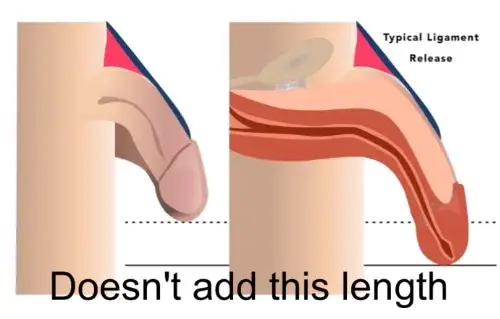
What is it?
Surgical ligation of the fundiform and superficial upper ligaments.
A superficial ligament release is the most common procedure performed with penile lengthening in the U.S. at this moment.
It’s also the least successful and can result in lost length if a patient is not dedicated to post-surgical stretching, as the resulting scar tissue from the incisions can pull the penis inward.
Impact on Penile Lengthening
Rarely provides any immediate lengthening 3 unless the patient has inordinately tight superficial ligaments.
Retention of deep ligaments which are anchored to the pelvic bone hinders any success with any additional length from post-surgical stretching.
Estimated Length Increase
0.25 inch (assuming only 25% of patients will perform post-operative stretching as prescribed)
[3] Giancarlo Marra MD, et al, Systematic Review of Surgical and Nonsurgical Interventions in Normal Men Complaining of Small Penis Size, Sexual Medicine Reviews, Volume 8, Issue 1, January 2020, Pages 158-180
Superficial and deep ligaments release
What is it?
Surgical ligation of the fundiform, superficial, and the deep ligaments.
Impact on Penile Lengthening
Rarely any immediate length unless patient has inordinately tight superficial ligaments. Release of the deep ligaments offers opportunity for increased length from post-operative stretching.
Average Length Increase
0.5 inch (assuming only 25% of patients will perform the six months of prescribed post-surgical stretching)
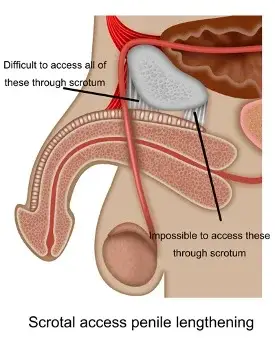
Superficial ligament release through scrotum
What is it?
Surgical ligation of the fundiform and superficial ligaments performed through the scrotum, resulting in no visible scar above the base of the penis.
Impact on Penile Lengthening
Rarely any immediate length unless patient has inordinately tight superficial ligaments. Retention of deep ligaments hinders any success with any additional length from post-surgical stretching.
Average Length Increase
0.25 inch (assuming only 25% of patients will perform the six months of prescribed post-surgical stretching)
Silicone implant
What is it?
Surgical installation of a prosthetic implant around the penis organ beneath the epidermis.
Impact on Penile Lengthening
Primary impact is upon increasing penile girth. Does not promise to or deliver increased penile length.
Average Length Increase
0.25 inch
V-Y advancement with superficial and deep ligament release (VY Plasty)
What is it?
By creating incisions at the base of the penis and moving the tissue upward to create the appearance of a longer flaccid penis, this operation produces the desired result.
The V-Y advancement after making a V-Y incision is frequently performed in conjunction with an upper suspensory and deep ligament release.
Typically, an inverted V-shaped incision is followed by an inverted Y-shaped closure; this closure technique elongates the dorsal skin by repositioning lateral tissue along the midline.
The first description of penile elongation via dorsal V-Y incision in penises dates back more than four decades.
Before we invented penile repositioning, we successfully performed suspensory and deep ligament release treatment with a VY-Plasty and thought of it as our best penile lengthening procedure at that time.
VY-Plasty can sometimes produce the illusion of a lengthier penis. However, the physiological length of your penis remains unchanged unless the ligaments were inordinately tight.
Impact on Penile Lengthening
Rarely any immediate length unless patient has unusually tight superficial ligaments, although the penis often visually appears longer from the rearrangement of skin.
Average Length Increase
0.7 inch
Medical non-surgical penile lengthening
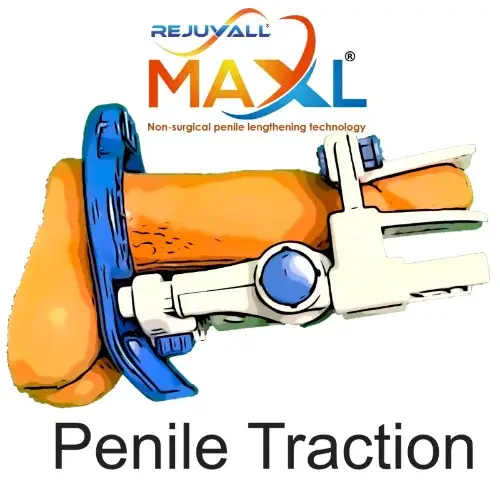
What is it?
Lengthening a penis through various types of stretching has existed for over 100 years. However, this approach has only recently been provided under the controlled care of doctors. Performed correctly and safely, it can prove successful in increasing the length of a penis.
What’s the difference between medical stretching and men who try to lengthen their penis through stretching using tips from websites? The biggest contradiction is safety.
Most men don’t understand, or simply fail to accept that their penis is a human organ with similar design and complexity to the human heart.
Organs are easily prone to injury because of their complex function. Men who enjoy “successful” increased length in their 20s, 30s, and even 40s have no concept of the fact they’ve actually injured their penis organ quite often throughout that process.
Nor do they have any idea of the hell they will face in their 50s and beyond as their body can no longer fight off the horrific symptoms that occur following penile injury, including drastic size reduction and lost function.
On the completely opposite end of the spectrum, however, medical penile stretching prioritizes safety with good results.
Impact on Penile Lengthening
When performed correctly, up to one inch of increased penile length (although most commonly about half that amount).
Average Length Increase
0.6 inch
MegaMAXL penile repositioning lengthening
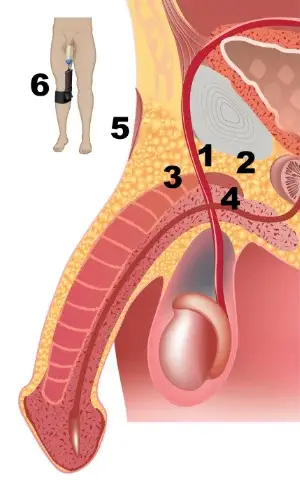
What is it?
Surgical ligation of the fungiform, superficial, and deep ligaments, plus penile repositioning, length lock, and added structural support.
MegaMAXL penile lengthening is a new surgical lengthening innovation developed by renowned reconstructive urologist and penile trauma surgeon Kenneth J. Carney, MD, PHARM, FACS.
A penis consists of a “visible” external part and an “invisible” internal part that is buried inside the suprapubic area.
Early understanding was that release of the penile suspensory ligaments would cause the invisible portion of the penile organ to become visible following surgery. Alas, as this page and the studies we shared show, that outcome very rarely happens.
Dr. Carney developed the MegaMAXL procedure as a far more comprehensive approach to penile lengthening, based upon successes he and his colleagues achieved during a fellowship that included treating infant males afflicted with hypospadias after birth.
Impact on Penile Lengthening
Guarantee of at least 1 inch of added length immediately after surgery.
Average Length Increase
1.25 inches (assuming only 25% of patients perform the six months of prescribed post-surgical stretching)
SuperMAXL penile repositioning PLUS non-surgical lengthening
What is it?
The SuperMAXL is a combination procedure that integrates two procedures: medical stretching joined with a MegaMAXL penile repositioning procedure to offer the most impactful penile lengthening procedure available anywhere.
Impact on Penile Lengthening
Guarantees at least two inches of increased penile length from beginning to after your surgical procedure. Even more length can sometimes be achieved through a prescribed post-surgical stretching regimen.
Average Increased Penile Length
2.25 inches (2 inches of increased length is assured with money back guarantee)
MegaContour penile lengthening
What is it?
A common approach to penile lengthening for men with an engorged suprapubic fat pad is to first perform a fat pad reduction procedure, followed a few months later by a penile lengthening surgery.
Liposuction of the fat pad rarely creates a long term positive outcome for men over the age of 30 due to reduced skin elasticity.
As the founder of America’s only GURS fellowship for board-certified urologists training in surgical care for penile restoration of morbidly obese patients, Kenneth J. Carney, MD, PHARM, FACS discovered it was essential to resolve penile lengthening issues at the same time the fat pad is surgically reduced for optimal results.
Thus, he created a “lite” version of those monumental hospital procedures for more prototypical men with an engorged fat pad.
Known as a “MegaContour,” this procedure includes surgical removal of the engorged fat pad and contouring of the lower stomach to the newly reduced fat pad, plus penile lengthening.
In cases where the dartos has detached from the body, a reconstructive urologic procedure is performed to prevent further loss of penile size.
Impact on Penile Lengthening
Varies by patient.
Average Increased Penile Length
1.5 inches
Suspensory Ligament Surgery for Penile Lengthening: Conclusions
Suspensory Ligaments
Suspensory ligaments are fibrous membranes that serve the function of maintaining an organ or anatomical component in a suspended state. There are numerous suspensory ligaments in the human body, not just those that attach to the penis.
Penile Enlargement
Since the beginning of time, men have had a desire to enlarge their penis. Men with average sized genitalia are just as likely to seek enlargement as men with a small endowment.
There are presently no accepted standards with procedures for penile lengthening. Increasing penile length is considerably more challenging than increasing penile thickness due to the fact that the penis is a human organ and medical science is currently incapable of enlarging human organs.
Penile Suspensory Ligaments
Because some clinicians refer to their procedure for lengthening the penis as a “ligament release,” patients may be led to believe that only one ligament is incised. In reality, the suspensory ligaments comprise three distinct collections of connective tissues and ligaments that collectively provide support to the erect penis.
Cutting the Suspensory Ligaments
Ligation of the suspensory ligaments to elongate the penis continues to be a prevalent technique, having been initially devised in 1971. Some males are congenitally endowed with ligamentous structures that are unusually tense.
It appears that only males with excessively taut ligaments experience an increase in length following a standard ligament ligation procedure, according to studies.
The penis never points “straight down” after the suspensory ligaments are incised. However, the average change in erect angle while standing is about 20% following such a procedure.
Procedures to Lengthen a Penis
Presently, there exist approximately ten distinct procedures utilized for the purpose of penile lengthening, with estimated mean increases in penile length ranging from 0.1 inches to 2.25 inches.
Advertised post-procedure results predicated upon “our patients’ reports” should be regarded with skepticism and are far less valuable than “guaranteed outcomes.”

